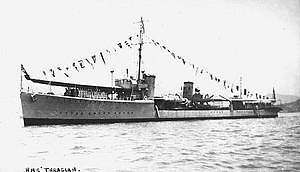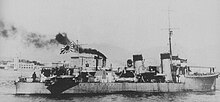HMS Thracian (1920)
 HMS Thracian in 1941 | |
| History | |
|---|---|
| Name: | HMS Thracian (D86) |
| Ordered: | 1915 |
| Builder: |
|
| Laid down: | 17 January 1918 |
| Launched: | 5 March 1920 |
| Commissioned: | 1 April 1922 |
| Fate: | Grounded on 25 December 1941 at Aberdeen, Hong Kong |
| General characteristics HMS Thracian | |
| Class and type: | S-class destroyer |
| Displacement: | 1,075 long tons (1,092 t) |
| Length: | 276 ft (84 m) o/a |
| Beam: | 26 ft 8 in (8.13 m) |
| Draught: | 9 ft (2.7 m) |
| Installed power: |
|
| Propulsion: | 2 Shafts; 2 steam turbines |
| Speed: | 36 knots (67 km/h; 41 mph) |
| Range: | 2,750 nmi (5,090 km; 3,160 mi) at 15 knots (28 km/h; 17 mph) |
| Complement: | 90 |
| Armament: |
|
| Name: |
|
| Builder: | Navy 2nd Construction Department at Hong Kong |
| Acquired: | 1942 |
| Commissioned: | 1 October 1942 |
| Decommissioned: | 1945 |
| In service: | 1942-1945 |
| Renamed: |
|
| Reclassified: | Training ship, 15 March 1944 |
| Reinstated: | Returned to Royal Navy in October 1945 |
| Fate: | Scrapped, February 1946 |
| General characteristics Patrol Boat No.101 | |
| Class and type: | Patrol boat/Training ship |
| Displacement: | 1,150 long tons (1,168 t) standard |
| Length: | 80.79 m (265 ft 1 in) Lpp |
| Beam: | 8.17 m (26 ft 10 in) |
| Draft: | 3.01 m (9 ft 11 in) |
| Propulsion: |
|
| Speed: | 25 knots (29 mph; 46 km/h) |
| Complement: |
|
| Sensors and processing systems: | Mk. 23 gunfire control radar (1944) |
| Armament: |
|
HMS Thracian was an S-class destroyer built for the Royal Navy during the First World War.
Contents
1 Description
2 Construction and career
3 Imperial Japanese Navy service (1942 – 1945)
4 Notes
5 Bibliography
6 Further reading
Description
The S-class destroyers were improved versions of the preceding Modified R class. They displaced 1,075 long tons (1,092 t).[1] The ships had an overall length of 276 feet (84.1 m), a beam of 26 feet 8 inches (8.1 m) and a draught of 9 feet (2.7 m). They were powered by two Brown-Curtis geared steam turbines, each driving one propeller shaft, using steam provided by two Yarrow boilers. The turbines developed a total of 27,000 shaft horsepower (20,000 kW) and gave a maximum speed of 36 knots (67 km/h; 41 mph). The ships carried a maximum of 301 long tons (306 t) of fuel oil that gave them a range of 2,750 nautical miles (5,090 km; 3,160 mi) at 15 knots (28 km/h; 17 mph). The ships' complement was 90 officers and ratings.[2]
Thracian was armed with three QF 4-inch (102 mm) Mark IV guns in single mounts and a single 2-pounder (40 mm) "pom-pom" anti-aircraft gun. The ship was fitted with two twin mounts for 21-inch (533 mm) torpedoes.[1] Two additional single mounts were positioned abreast the bridge at the break of the forecastle for 18-inch (45 cm) torpedoes. All torpedo tubes were above water and traversed to fire.[3]
Construction and career
HMS Thracian was laid down on 17 January 1918 at Hawthorn Leslie and Company, launched on 5 March 1920 and completed at Sheerness Dockyard on 1 April 1922. The ship was run aground and scuttled at Hong Kong on 25 December 1941, later captured by the Imperial Japanese Army.

IJN Patrol Boat No. 101 in 1942

IJN Special Training Ship No. 1 in 1945
- 1 October 1942: Registered to naval ship list in the Imperial Japanese Navy, and classification to the Special service ship (Patrol boat). Renamed
Patrol Boat No. 101.
- 25 November 1942: Repairs were completed by the Navy 2nd Construction Department, and assigned to the Yokosuka Naval District.
- (after): She spent her time on convoy escort operations in the Yokosuka Area.
- 15 August 1943: Assigned to the Torpedo warfare school (Yokosuka).
- 15 March 1944: Classification to the miscellaneous ship (Training ship), and renamed Special Training Ship No. 1. She was used for a test bed for new weapons.
- 15 August 1945: Survived war at Yokosuka.
- October 1945: Returned to Royal Navy.
- February 1946: Scrapped at Hong Kong.
Notes
^ ab Gardiner & Gray, pp. 84–85
^ Lenton, p. 137
^ Friedman, p. 169
Bibliography
Dittmar, F.J. & Colledge, J.J. (1972). British Warships 1914–1919. Shepperton, UK: Ian Allan. ISBN 0-7110-0380-7..mw-parser-output cite.citationfont-style:inherit.mw-parser-output qquotes:"""""""'""'".mw-parser-output code.cs1-codecolor:inherit;background:inherit;border:inherit;padding:inherit.mw-parser-output .cs1-lock-free abackground:url("//upload.wikimedia.org/wikipedia/commons/thumb/6/65/Lock-green.svg/9px-Lock-green.svg.png")no-repeat;background-position:right .1em center.mw-parser-output .cs1-lock-limited a,.mw-parser-output .cs1-lock-registration abackground:url("//upload.wikimedia.org/wikipedia/commons/thumb/d/d6/Lock-gray-alt-2.svg/9px-Lock-gray-alt-2.svg.png")no-repeat;background-position:right .1em center.mw-parser-output .cs1-lock-subscription abackground:url("//upload.wikimedia.org/wikipedia/commons/thumb/a/aa/Lock-red-alt-2.svg/9px-Lock-red-alt-2.svg.png")no-repeat;background-position:right .1em center.mw-parser-output .cs1-subscription,.mw-parser-output .cs1-registrationcolor:#555.mw-parser-output .cs1-subscription span,.mw-parser-output .cs1-registration spanborder-bottom:1px dotted;cursor:help.mw-parser-output .cs1-hidden-errordisplay:none;font-size:100%.mw-parser-output .cs1-visible-errorfont-size:100%.mw-parser-output .cs1-subscription,.mw-parser-output .cs1-registration,.mw-parser-output .cs1-formatfont-size:95%.mw-parser-output .cs1-kern-left,.mw-parser-output .cs1-kern-wl-leftpadding-left:0.2em.mw-parser-output .cs1-kern-right,.mw-parser-output .cs1-kern-wl-rightpadding-right:0.2em
Friedman, Norman (2009). British Destroyers: From Earliest Days to the Second World War. Barnsley, UK: Seaforth Publishing. ISBN 978-1-84832-049-9.
Gardiner, Robert & Gray, Randal (1985). Conway's All The World's Fighting Ships 1906–1921. London: Conway Maritime Press. ISBN 0-85177-245-5.
Lenton, H. T. (1998). British & Empire Warships of the Second World War. Annapolis, Maryland: Naval Institute Press. ISBN 1-55750-048-7.
Further reading
- Rekishi Gunzō, History of Pacific War Vol.45, Truth histories of the Imperial Japanese Naval Vessels, Gakken (Japanese publisher), May 2004,
ISBN 4-05-603412-5.
Ships of the World, special issue Vol.45, Escort Vessels of the Imperial Japanese Navy, "Kaijinsha"., (Japan), 1996.
The Maru Special, Japanese Naval Vessels No.49, "Japanese submarine chasers and patrol boats", "Ushio Shobō". (Japan), 1981.